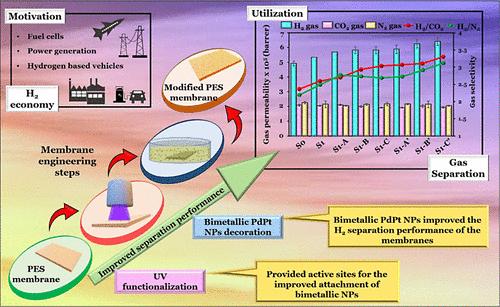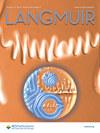用于增强 H2 分离的双金属 PdPt 纳米粒子装饰聚醚砜膜
IF 3.7
2区 化学
Q2 CHEMISTRY, MULTIDISCIPLINARY
引用次数: 0
摘要
从清洁能源生产到气体净化,氢分离在各种应用中都具有重要意义。膜技术是一种低成本、高效率的方法。开发高效的气敏材料可以进一步提高膜的性能。为此,我们采用湿化学方法合成了双金属钯铂纳米粒子,并将其战略性地装饰到聚醚砜(PES)膜上。聚醚砜膜的纤维状形态为纳米粒子的装饰提供了理想的平台,有望增强气体传输特性。在附着纳米粒子之前,先在紫外线下对膜进行预处理,以增强其表面特性并提高附着力。利用透射电子显微镜和 X 射线光电子能谱对合成的双金属纳米粒子进行了形态和元素分析。此外,还利用傅立叶变换红外光谱(FTIR)、拉曼光谱和场发射扫描电子显微镜(FESEM)等多种技术对工程膜进行了严格的表征,以确保全面了解其结构、化学和形态特性。使用纯 H2、N2 和 CO2 气体对膜的分离性能进行了检测,结果显示 H2 渗透率提高了 30%,H2/CO2 和 H2/N2 选择性分别提高了 40% 和 42%。这些发现证实了量身定制的材料设计和合成策略在推进 H2 分离应用的膜技术中的关键作用。本文章由计算机程序翻译,如有差异,请以英文原文为准。

Bimetallic PdPt Nanoparticles Decorated PES Membranes for Enhanced H2 Separation
Hydrogen separation has significant importance in diverse applications ranging from clean energy production to gas purification. Membrane technology stands out as a low-cost and efficient method to address the purpose. The development of efficient gas-sensitive materials can further bolster the membrane’s performance. In this pursuit, bimetallic PdPt nanoparticles were synthesized using a wet chemical approach and were strategically decorated onto poly(ether sulfone) (PES) membranes. The fibrous morphology of the PES membranes provided an ideal platform for the decoration of nanoparticles, promising enhanced gas transport properties. Prior to the attachment of nanoparticles, the membranes were pretreated under UV light to enhance their surface properties and facilitate improved adhesion. The synthesized bimetallic nanoparticles were characterized by using transmission electron microscopy and X-ray photoelectron spectroscopy for their morphological and elemental analysis. Furthermore, the engineered membranes were characterized using various techniques, such as Fourier transform infrared (FTIR) spectroscopy, Raman spectroscopy, and field emission scanning electron microscopy (FESEM) with rigorous scrutiny to ensure a comprehensive understanding of their structural, chemical, and morphological properties. The membranes were examined for their separation performance using pure H2, N2, and CO2 gases, and the results revealed a 30% increment in H2 permeability and 40 and 42% increments in H2/CO2 and H2/N2 selectivity, respectively. These findings confirmed the critical role of tailored material design and synthesis strategies in advancing membrane technologies for H2 separation applications.
求助全文
通过发布文献求助,成功后即可免费获取论文全文。
去求助
来源期刊

Langmuir
化学-材料科学:综合
CiteScore
6.50
自引率
10.30%
发文量
1464
审稿时长
2.1 months
期刊介绍:
Langmuir is an interdisciplinary journal publishing articles in the following subject categories:
Colloids: surfactants and self-assembly, dispersions, emulsions, foams
Interfaces: adsorption, reactions, films, forces
Biological Interfaces: biocolloids, biomolecular and biomimetic materials
Materials: nano- and mesostructured materials, polymers, gels, liquid crystals
Electrochemistry: interfacial charge transfer, charge transport, electrocatalysis, electrokinetic phenomena, bioelectrochemistry
Devices and Applications: sensors, fluidics, patterning, catalysis, photonic crystals
However, when high-impact, original work is submitted that does not fit within the above categories, decisions to accept or decline such papers will be based on one criteria: What Would Irving Do?
Langmuir ranks #2 in citations out of 136 journals in the category of Physical Chemistry with 113,157 total citations. The journal received an Impact Factor of 4.384*.
This journal is also indexed in the categories of Materials Science (ranked #1) and Multidisciplinary Chemistry (ranked #5).
 求助内容:
求助内容: 应助结果提醒方式:
应助结果提醒方式:


